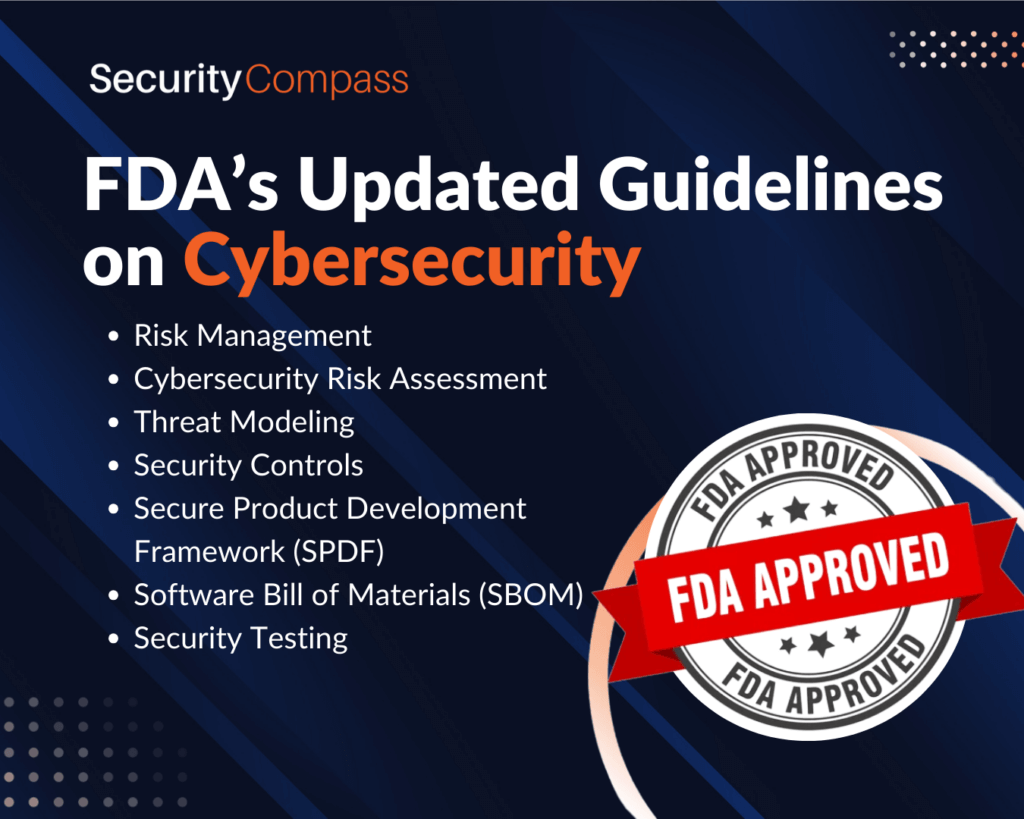The medical device industry is evolving rapidly, with innovation and connectivity pushing the boundaries of what is possible in healthcare. However, with this progress comes the need for stringent regulations to ensure the safety and efficacy of medical devices. The U.S. Food and Drug Administration (FDA) plays a crucial role in this regard, providing guidelines and standards for medical device product teams to follow.
Recently, the FDA updated its guidelines on cybersecurity for medical devices, emphasizing the importance of integrating robust security measures earlier in the product development lifecycle. Premarket submissions created after October 1, 2023 without sufficient cybersecurity design will be refused, which medical device product teams have already experienced. In this blog post, we delve into the key aspects of these new guidelines, providing medical device product teams with the information they need to navigate Premarket Submissions.
Understanding the FDA’s Updated Guidelines on Cybersecurity:
The FDA’s recent guidelines on cybersecurity for medical devices outline clear expectations for manufacturers, focusing on quality system considerations and the content required for premarket submissions after October 1, 2023.
Here’s a breakdown of the main areas of focus:
Risk Management: The FDA emphasizes the importance of a comprehensive risk management approach, encouraging medical device manufacturers to proactively assess cybersecurity risks during the device design and development process.
Cybersecurity Risk Assessment: Security risks and controls should be assessed for residual risks. The FDA recommends that manufacturers assess identified risks according to the level of risk posed from the device and the system in which it operates, including security architecture designs that include a multi-patient harm view and a patchability view.
Threat Modeling: A process for identifying security threats across the medical device system, and then defining countermeasures to prevent, mitigate, monitor, or respond to these threats. FDA recommends threat modeling be performed throughout the design process and include all medical device system elements.
Security Controls: FDA guidelines highlight the need for robust security controls to protect medical devices from cybersecurity threats. Manufacturers are urged to adopt security by design practices that are industry-recognized to ensure security is “built-in” to a device and not “bolted on” after the device is designed.
Secure Product Development Framework (SPDF): To comply with the QS regulation and cybersecurity, the FDA encourages manufacturers to deploy robust security processes to identify and mitigate security vulnerabilities in products. SPDF encompasses all aspects of the product lifecycle to reduce the need to re-engineer devices after they are released.
Software Bill of Materials (SBOM): The FDA is requesting an SBOM, a detailed inventory of all software components used in a medical device, including manufacturer-developed and third-party components. An SBOM facilitates risk management processes by helping device manufacturers and users identify potential security risks in a timely manner.
Security Testing: Rigorous security testing is a critical component of the FDA’s cybersecurity guidelines. Manufacturers must thoroughly validate the effectiveness of security controls, ensuring that devices are resilient against known and potential cybersecurity threats.
Documentation and Traceability: FDA guidelines mandate clear documentation and traceability of all cybersecurity activities, including records of risk assessments, security controls, testing results, and mitigation strategies. This documentation must provide valuable information for post-market surveillance and ongoing risk management.
Post-Market Surveillance: The FDA underscores the significance of continuously monitoring and assessing cybersecurity threats throughout the device’s lifecycle. Manufacturers are expected to have processes in place for the timely detection, response, and mitigation of cybersecurity incidents, ensuring the ongoing safety and effectiveness of the device.
Premarket Submission Content: These guidelines provide detailed instructions on the content required for premarket submissions, ensuring manufacturers provide sufficient evidence of their cybersecurity risk management practices. This includes documentation of risk assessments, security controls, testing results, and a plan for the device’s cybersecurity risk management.
Benefits from the FDA’s Updated Guidelines on Cybersecurity:
The FDA’s updated guidelines on cybersecurity for medical devices mark a significant step forward in ensuring the safety and security of medical technologies. By integrating cybersecurity considerations into the product development lifecycle, medical device manufacturers can proactively address potential vulnerabilities, protect patient data, and ensure the ongoing effectiveness of their products without needing to re-engineer them.
Similar to previous human factors guidance, medical device product teams must familiarize themselves with these new guidelines, adopt a cybersecurity risk management approach and implement robust security controls to meet the FDA’s expectations. Documentation, testing, and post-market surveillance play crucial roles in maintaining the trust of users.
By adhering to the FDA’s guidelines, medical device manufacturers can contribute to a safer healthcare ecosystem, which fosters innovation while ensuring the security, quality and reliability of their products. The journey toward premarket submission may be complex, but the rewards—regarding patient safety and product integrity—are well worth the effort.
Premarket Submissions using SD Elements
By leveraging SD Elements, medical device manufacturers can confidently navigate the FDA’s new cybersecurity guidelines for premarket submissions in a scalable and repeatable manner.
The relentless pace of innovation with medical devices brings forth unparalleled opportunities to enhance patient care, delivering better health outcomes. These new FDA guidelines are intended to help medical device manufacturers avoid re-engineering their products to address known and potential cybersecurity threats. Understanding and implementing these guidelines across the product development lifecycle can pave the way for a safer, more secure future.
SD Elements offers a platform to manage and automate the risk management process. Threats are identified earlier in the product development lifecycle, and countermeasures are effectively communicated to product teams within tools they already use, including JIRA, Azure DevOps, GitLab, GitHub and ServiceNow. Countermeasures include actionable guidance, how-to code snippets, how-to configuration guidance and just-in-time training. SD Elements allows teams to mitigate cybersecurity risks without resorting to re-engineering.
SD Elements tailors security controls to each element of the medical device system, preventing product teams from wasting hours sifting through documentation. SD Elements also provides enhanced traceability and transparency by seamlessly tracking these security controls to completion using advanced reporting techniques. SD Elements dashboards allow product teams to quickly see the progress of numerous new products and new features. SD Elements provides a mechanism to track and manage security-related activities to demonstrate compliance and streamline the entire cybersecurity workflow.
As medical devices continue to evolve, so do cybersecurity threats. SD Elements fosters a culture of continuous improvement, offering tools and resources for ongoing risk assessment and security enhancement. Content within SD Elements is updated to include emerging changes to technologies, platforms, programming languages, standards and regulations. SD Elements ensures that product teams stay ahead of emerging threats, maintain device integrity and retain patient trust.
Discover the impact of SD Elements in the medical devices sector. Ready to explore how it can transform your operations? Reach out to us now. Or, if you’re eager to witness SD Elements’ capabilities immediately, view our instant product tour here.










